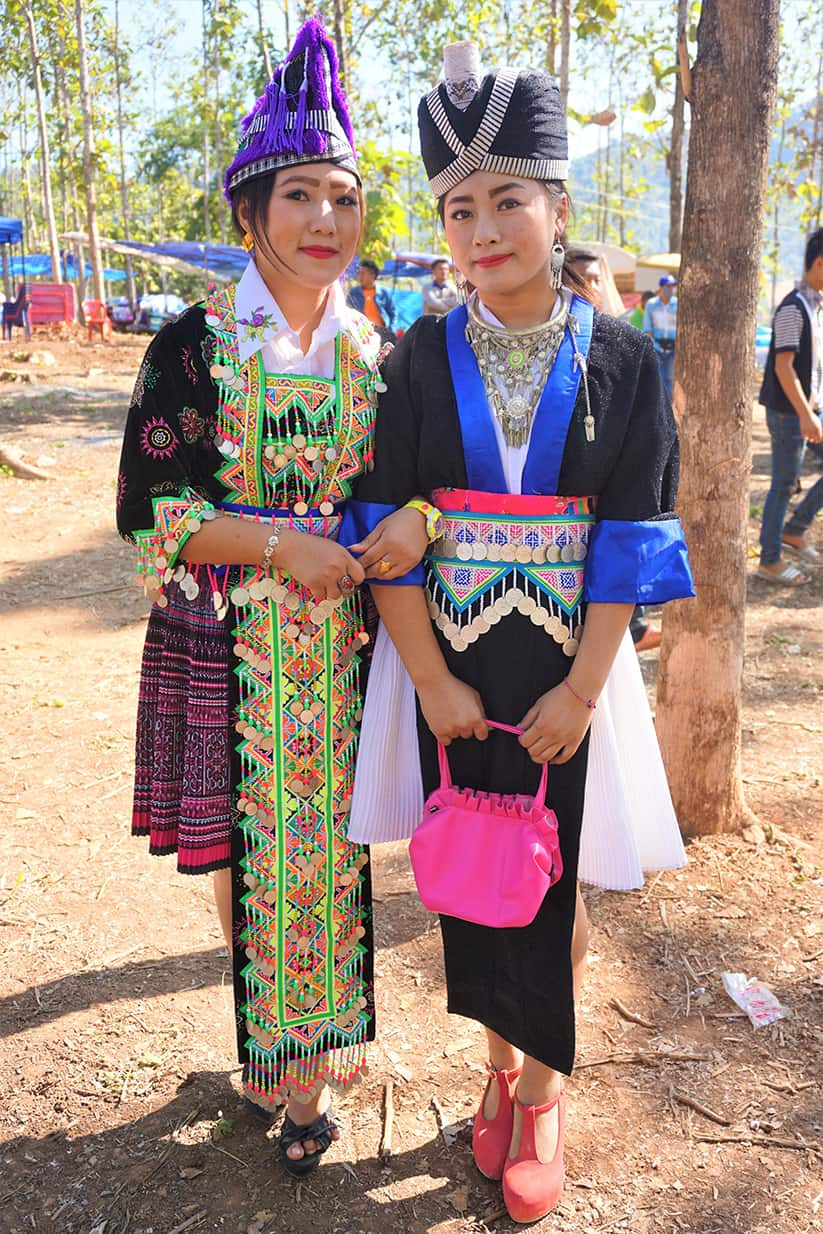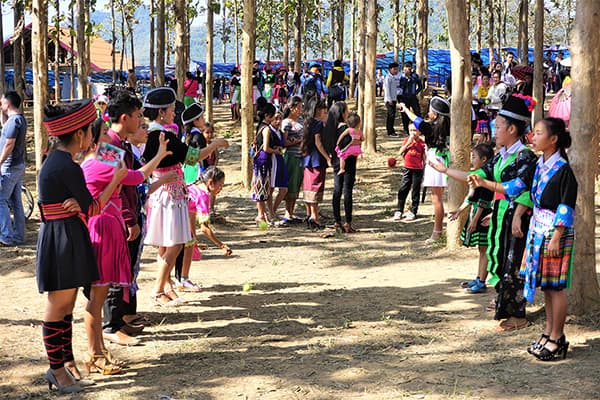Nina Boys is our guest blogger for the second time. Nina is an avid explorer and passionate traveler whose journeys have taken her across five continents to some of the world’s most beautiful natural and cultural wonders. She has served as a judge for the National Geographic World Legacy Awards, honoring the planet’s sustainable travel visionaries, and has a knack for finding unique travel experiences wherever she goes. She is known to seek out up-and-coming art scenes, local delicacies at street food stands around the world, and opportunities to scuba dive on vibrant coral reefs, all while blogging about her off-the-beaten path adventures for publications including Virtuoso.com, Huffington Post and Roads & Kingdoms.

Originally from China, the Hmong (pronounced: mong) migrated to Laos during the 19th century and today are among the most prominent of the nation’s 49 government-recognized ethnic groups. Travelers often visit their villages spread throughout Laos’ lush northern hills on guided treks, but those looking for a truly authentic cultural experience can do no better than attending a Hmong New Year party where their unique traditions are on full display. Participants prepare all year for the multi-day celebrations that begin in individual villages before snowballing into larger parties where normally isolated communities gather to socialize, perform – and perhaps most importantly – court romantic partners outside of their own clans. One of the largest of these takes place in the outskirts of the nation’s former royal capital, Luang Prabang, which draws nearly 1,000 participants from across the region at the end of the twelfth lunar calendar month. Earlier that morning I watched the Mekong’s espresso-tinted currents swirl lazily past the majestic city – until the sharp horn of a truck full of locals ready to party snaps me back to reality. Summoned to join the caravan, I hop in the back as we set off along dusty roads leading to the city’s outer limits where a sparsely populated forest has been decked out with stages, carnival games, an impressive array of homemade photo booths, and numerous al fresco food stands. I beeline for the low plastic stools that all but guarantee a delicious meal in Laos and am not disappointed when a steaming bowl of aromatic noodles laced with lemongrass is ladled from the large metal cauldron simmering atop open flames and passed my way. The Hmong harvest season has just ended and the fruits of their labor can be savored in a variety of traditional dishes here, including the chili-spiked sausages sizzling on the grill beside me, just waiting to be paired with homemade rice whiskey or the beloved national Beerlao.

Explore Laos as well as Cambodia on our Cambodia and Laos section for exceptional Southeast Asia journeys.
In honor of Easter, we thought we’d talk about eggs… Well, one egg anyway. You may be surprised to learn that the animal responsible for producing the largest egg is a shark. It is the whale shark, a carpet shark and the largest known extant fish species. The animal holds the egg inside its body until it hatches. The largest whale shark egg ever recorded measured 12 inches long, 5.5 inches wide and 3.5 inches thick.
The fish are also rather large. The species was first singled out in 1828 after one was harpooned in Table Bay, South Africa. Thought to be a whale, it was 4.6 m/15 ft long. The name, of course, refers to its size, which can be as large as some species of whale. Whale sharks have very large mouths that can be 1.5 m/4.9 ft wide, containing 300 to 350 rows of tiny teeth and are filter feeders, which is found in only two other sharks, the megamouth shark and the basking shark. They feed almost exclusively on plankton and small fishes and pose no threat to humans.
This fascinating species inhabits all tropical and warm-temperate seas of the planet. It is the largest non-cetacean animal alive today. The average size of an adult whale shark is estimated at 9.8 m/32 ft, weighing nine tons. Yes, that’s about 20,000 pounds, although several specimens have been reported at more than 18 m/59 ft long. The largest verified specimen was caught on November 11, 1949, near Baba Island, in Karachi, Pakistan. It was 12.65 m/41.5 ft long, and weighed some 21.5 tons/47,000 pounds with a girth of 7 m/23 ft.
Seasonal feeding aggregations occur at several coastal sites including South Africa, Saint Helena Island in the South Atlantic Ocean; Gulf of Tadjoura in Djibouti, Gladden Spit in Belize and Ningaloo Reef in Western Australia.
The whale shark holds many records for size in the animal kingdom, most notably being by far the largest living nonmammalian vertebrate. It is the sole member of the genus Rhincodon and the only extant member of the family Rhincodontidae.
Rarely found in waters below 21 °C/(70 °F, whale sharks’ lifespan is thought to be about 70 years. Some estimates from data collected in the field seem to suggest they may be able to live to a remarkably old age of 130 years.
As noted above, one of the best places to encounter these gentle giants is in Western Australia’s Ningaloo Reef, where you have the opportunity to not only see whale sharks, but also meet them on their own terms – take a swim with them during our 14-day Wild Australia adventure.
This seems a time when out-of-the-box creativity is sorely needed to solve some of our more intractable global problems. Cambodia, for example, is fighting to move away from poverty, but many families still struggle day by day to find food and safe water enough for their families and adequate shelter.
And HUSK is there to help, supported by the owners of Sojourn Boutique Villas. HUSK “works directly with communities to help improve the lives of Cambodian families. Our goals focus around the basics of providing access to safe water, livelihood opportunities, health, education and environment.”
The directors are all volunteers and only local Khmer staff are paid by HUSK, which focuses on the basics – food, water and a safe place to stay.
That’s where the eco brinks come in.
Like so many impoverished countries, once outside the larger tourist areas, the problem of trash becomes obvious. Away from the main tourist parts of Siem Reap, rubbish collection is simply not available. Even when it is, families cannot always afford to take advantage of it. It doesn’t help that there is a serious lack of awareness or education about environmental issues.
The waste is left scattered around villages or in most cases burnt –both options are undesirable. Litter has become a major community health issue across Cambodia.
Enter eco bricks!
HUSK searched for a solid solution to the very real pollution problems caused by excessive rubbish. They discovered that plastic bottles (one of the biggest contributors) as well as other trash could be used as building materials. They set out to build the first bottle buildings from these ‘eco’ bricks in Cambodia.
The idea is to fill each bottle with ‘clean’ throwaway items such as straws, plastic bags and polystyrene trays to begin to create each eco brick. The bricks are then bound together with chicken wire before the entire construction is fixed with cement and painted. The end result is a building that looks to be made of actual bricks.
Brilliant – two birds, one brick!
So far, HUSK has used more than 100,000 bottles to create a medical center, three classrooms, an income generation workshop, a toilet block and fencing, while at the same time spreading this invaluable idea to other communities.
They have other projects focusing on education, safe water and more. As a visitor, you, too, can be a part of the solution with their Day in a Life project. You have the unique opportunity to step inside the shoes of a villager and share a day in their community. This adventure allows you to meet and interact with local people in a respectful and meaningful way, help your host family with a work project and share lunch with them.
Experience these special destinations in our new 15-day The Land, The People of Vietnam & Cambodia.